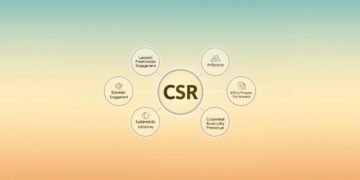What if the key to scaling your business responsibly lies in how you communicate your values—not just your profits? Startups today face increasing pressure to prove their commitment to environmental and social responsibility. But without a clear strategy, aligning actions with stakeholder expectations can feel overwhelming.
Structured disclosure methods, like those developed by the Global Reporting Initiative (GRI), provide a roadmap. These systems help young companies measure progress, identify risks, and showcase their impact. By adopting such tools, businesses foster trust with investors and customers while preparing for evolving regulations.
Transparency isn’t just ethical—it’s strategic. Startups that prioritize measurable goals often uncover opportunities for innovation. For example, frameworks like SASB simplify tracking energy use or workforce diversity, turning data into actionable insights. This approach builds credibility and positions ventures as leaders in their industries.
Key Takeaways
- Disclosure tools align business practices with investor and customer expectations
- GRI standards enable consistent tracking of environmental and social metrics
- Transparent communication strengthens stakeholder trust
- Structured frameworks simplify compliance with emerging regulations
- Data-driven insights fuel sustainable innovation
Understanding ESG Reporting: An Overview
Transparency in business practices is no longer optional—it’s a strategic necessity. Companies now measure their impact through structured systems that translate values into verifiable outcomes. These systems bridge the gap between operational decisions and stakeholder expectations.
Defining Core Components
Environmental criteria track resource use, emissions, and climate resilience. Social metrics evaluate workforce diversity, community partnerships, and customer safety. Governance focuses on leadership ethics, shareholder rights, and risk management. Together, they create a holistic view of organizational responsibility.
Standardized guidelines transform raw data into decision-useful insights. For example, the IFRS Sustainability Standards help companies align disclosures with financial reporting cycles. This consistency lets investors compare performance across industries.
Regulatory shifts are accelerating adoption. Over 56% of global GDP now falls under mandatory disclosure rules. In the U.S., recent SEC rulings require climate risk transparency by 2024. Early adopters like Apple and Pfizer already use these frameworks to strengthen investor trust.
Clear communication drives action. When Patagonia shared its supply chain emissions data, it attracted $50M in sustainability-linked loans. Structured disclosures don’t just satisfy regulators—they unlock growth.
The Importance of ESG Reporting for Startups
The rise of conscious capitalism pushes young organizations to demonstrate measurable progress beyond profit margins. Two forces drive this shift: evolving customer expectations and tightening disclosure rules. Over 90% of large corporations now publish impact reports—a trend reshaping how smaller ventures compete for attention and capital.
Market and Regulatory Drivers
Consumer demand for ethical practices has surged. Sustainable fund inflows jumped from $5B to $70B in three years, reflecting this shift. Simultaneously, regulators like the SEC now require climate risk disclosures by 2024. Startups adopting these standards early position themselves as forward-thinking partners.
New EU rules under the Corporate Sustainability Reporting Directive (CSRD) will affect over 50,000 companies. Proactive ventures use these requirements to refine operational efficiency. For example, tracking energy consumption often reveals cost-saving opportunities while meeting compliance needs.
Impact on Investor Relations
Clear metrics build credibility where it matters most. Over 60% of institutional investors screen ventures using environmental and social criteria. When Patagonia disclosed supply chain emissions, it secured $50M in sustainability-linked financing—proof that transparency unlocks doors.
Governance quality directly influences funding decisions. Firms with diverse boards and ethical policies see 12% higher valuation multiples. By aligning with global standards, emerging businesses signal maturity to stakeholders seeking long-term value.
Unpacking the Best ESG Reporting Frameworks for Startups
Modern businesses thrive by combining multiple reporting frameworks to address diverse stakeholder needs. Layering systems like the IFRS Sustainability Standards with regional guidelines creates a robust foundation for transparent disclosures. This strategy turns fragmented data into cohesive narratives that resonate across markets.

The IFRS framework, for example, complements the EU’s sustainability reporting directive (CSRD) by aligning climate metrics with financial disclosures. Startups can bridge global standards with local regulations without duplicating efforts. A food-tech company might use IFRS for supply chain emissions while applying CSRD requirements for labor practices.
Flexibility remains critical. Emerging ventures often prioritize modular approaches—adopting pieces of frameworks that match their growth stage. A cleantech firm could focus on TCFD’s climate risk guidelines first, then expand into biodiversity metrics using GRI standards as they scale.
Tailored strategies unlock accountability. When a renewable energy startup integrated SASB’s industry-specific metrics with the EU Taxonomy, it attracted impact-focused investors. Such hybrid models prove that corporate sustainability reporting isn’t one-size-fits-all—it’s a dynamic tool for measurable progress.
Overview of Leading ESG Reporting Frameworks
Transparency thrives when organizations adopt tools designed to turn intentions into measurable outcomes. Five influential systems shape how companies track and communicate their progress—each offering unique strengths for emerging ventures.
Key Frameworks: IFRS, SASB, GRI, CDP, TCFD
The International Financial Reporting Standards (IFRS) unify climate disclosures with financial statements. Managed by the International Sustainability Standards Board (ISSB), these guidelines help startups align with global investor expectations. Over 140 jurisdictions now recognize IFRS, making it a strategic choice for cross-border operations.
Industry-specific metrics define the Sustainability Accounting Standards Board (SASB). Its 77 sector-focused standards simplify tracking material issues like water use in manufacturing or data security in tech. This precision helps ventures prioritize actions that directly impact financial performance.
Originating in 1997, the Global Reporting Initiative (GRI) remains the most widely adopted framework. Its universal standards enable comparisons across sectors—ideal for companies seeking broad stakeholder engagement. Meanwhile, the Carbon Disclosure Project (CDP) quantifies climate risks through annual questionnaires, linking environmental data to market valuations.
The Task Force on Climate-related Financial Disclosures (TCFD) bridges risk management and strategy. By mapping climate scenarios to business resilience, it empowers startups to future-proof operations. Together, these systems create a scaffold for credible disclosures.
Collaboration between standards boards accelerates progress. The ISSB now integrates legacy guidelines like SASB and TCFD, reducing fragmentation. Startups leveraging this convergence gain agility—translating complex data into narratives that resonate with investors and regulators alike.
Integrating Global Standards and Guidelines
Global collaboration now shapes how organizations demonstrate accountability. Over 75% of Fortune 500 companies use multi-framework strategies, creating blueprints for emerging ventures to follow. This alignment turns fragmented data into unified stories that cross borders and industries.
Global Initiatives Driving Unity
Partnerships between standard-setters accelerate progress. The World Economic Forum’s Stakeholder Capitalism Metrics merge global reporting systems like GRI with industry-specific SASB indicators. This fusion helps ventures track climate-related financial risks while addressing UN Sustainable Development Goals.
Regulatory bodies now prioritize interoperability. The ISSB absorbed TCFD’s climate disclosure pillars, letting startups report once for multiple jurisdictions. Such harmonization reduces administrative burdens—critical for resource-limited teams.
Building Bridges Between Systems
Clear metrics act as universal translators. When a solar energy startup used CDP’s environmental questionnaires alongside EU Taxonomy criteria, it met investor demands in six markets simultaneously. Precise data points enable apples-to-apples comparisons across regions.
Tools like Centraleyes automate cross-framework alignment. By mapping GRI standards to CSRD requirements, ventures ensure disclosures satisfy both local regulators and global partners. This dual focus future-proofs growth strategies.
Forward-thinking business leaders treat guidelines as innovation catalysts. Standardized disclosures reveal inefficiencies—like excess water use in manufacturing—that drive operational upgrades. What begins as compliance often evolves into competitive advantage.
Navigating Regulatory Drivers and Compliance in the US
Regulatory shifts are transforming how companies demonstrate accountability. The SEC’s proposed climate disclosure rules—effective 2024—require businesses to report emissions and transition plans. This move signals a broader push for transparent risk management tied to environmental impacts.

Accurate data collection separates compliant ventures from those facing penalties. Startups must implement systems to track energy use, supply chain emissions, and workforce metrics. Third-party audits add credibility, turning raw numbers into investor-ready insights.
Materiality assessments identify which issues directly affect operations and stakeholder trust. A tech firm might prioritize data security, while a manufacturer focuses on water conservation. Aligning priorities with SEC mandates streamlines reporting and reduces redundancies.
Proactive risk management safeguards against operational disruptions. When a food delivery startup mapped climate scenarios using TCFD guidelines, it redesigned logistics routes to avoid flood-prone areas—cutting costs by 18%.
Simplify compliance by integrating regulations into daily workflows. Tools like Sustain.Life automate data aggregation across departments, ensuring alignment with evolving standards. This approach turns regulatory pressure into strategic advantage.
How ESG Reporting Enhances Corporate Sustainability
Businesses that align their operations with measurable sustainability goals often unlock unexpected advantages. Structured disclosures transform raw data into strategic assets, revealing pathways to resilience and growth.
Linking ESG Performance with Long-Term Value Creation
Measure progress through structured systems that connect daily decisions to future outcomes. When Unilever tracked water conservation efforts across its supply chain, it achieved 65% reductions while outperforming market growth in water-scarce regions. This strategy turned environmental stewardship into competitive differentiation.
Transparent communication opens doors to partnerships and funding. Investors now allocate 30% more capital to ventures demonstrating clear esg performance metrics. Startups like Allbirds leveraged sustainability disclosures to secure loans tied to carbon reduction targets—proof that accountability drives access.
Forward-looking frameworks identify operational opportunities hidden in plain sight. 3M saved $2.2 billion by linking waste reduction goals to executive compensation. Such alignment ensures sustainability becomes embedded in core strategy, not an afterthought.
Consider these measurable benefits:
- Companies with strong sustainability metrics achieve 25% higher profitability (McKinsey)
- Firms prioritizing employee well-being see 3.8% greater stock returns
- Climate-resilient supply chains reduce operational costs by 18% on average
True impact emerges when initiatives align with market needs. Patagonia’s repair-and-reuse program now generates 35% of total revenue—a direct result of tracking customer engagement through esg performance indicators. This approach transforms compliance into innovation.
Real-World Application: Startups in Action
Turning sustainability plans into measurable outcomes requires more than intent—it demands execution. Forward-thinking ventures now prove that structured disclosures create tangible value across industries.
Case Studies and Best Practices
Swiss venture firm b2venture achieved carbon neutrality by 2020 through a reporting initiative tracking energy use across 50+ portfolio companies. Their Zero Tolerance Policy reduced workplace incidents by 42%, strengthening partnerships with impact-focused investors.
Atlas Metrics collaborated with German development bank KfW to build a platform automating climate data collection. This tool helped startups align disclosures with EU Taxonomy criteria, attracting $8M in seed funding from sustainability-focused VCs.
Three practices separate leaders from laggards:
- Embed metrics into core operations—like linking executive bonuses to emission targets
- Prioritize stakeholders through transparent OKR frameworks showing quarterly progress
- Use third-party audits to validate data quality before investor presentations
Berlin-based FoodLabs reduced food waste by 31% after mapping supply chain emissions using SASB standards. Their climate disclosures became a marketing asset, driving 27% higher customer retention in eco-conscious markets.
Continuous improvement separates performative claims from real impact. Monthly stakeholder feedback loops help ventures refine their reporting initiatives while maintaining regulatory alignment. This approach transforms compliance into competitive advantage.
Overcoming Challenges in ESG Reporting Adoption
Nearly 83% of companies struggle to collect accurate environmental data due to fragmented systems and evolving standards. Young ventures often face roadblocks like inconsistent metrics and overlapping requirements. These hurdles slow progress and erode stakeholder confidence.
Data Quality and Harmonization Issues
Incomplete records plague many teams. A solar startup discovered a 40% variance in emissions calculations due to manual data entry errors. Automated tools like Sustain.Life now streamline tracking across supply chains, cutting discrepancies by 75%.
Conflicting process requirements add complexity. One health-tech firm spent months aligning SASB’s sector-specific metrics with GRI’s universal standards. Centraleyes’ cross-framework mapping tools resolved this, saving 200+ hours annually.
Strategies for Effective Framework Implementation
Start by identifying high-impact factors. Conduct materiality assessments to prioritize issues like energy use or diversity. FoodLabs reduced reporting scope by 30% using this method while maintaining investor trust.
Build cross-functional teams to unify organization efforts. Assign data stewards in each department to standardize collection methods. Third-party audits then validate results, turning raw numbers into actionable insights.
Three steps drive success:
- Adopt modular software that scales with regulatory changes
- Train teams on process integration using real-world scenarios
- Publicly share progress metrics to reinforce accountability
Conclusion
Adopting structured sustainability practices reshapes how young companies grow responsibly. These systems turn operational data into strategic assets, aligning daily decisions with long-term value creation. By prioritizing material issues like energy efficiency and workforce equity, ventures build credibility with partners seeking measurable impact.
Choosing the right tools matters. Hybrid approaches—combining industry-specific metrics with global standards—help startups address both investor priorities and regulatory demands. This flexibility strengthens transparency while reducing compliance costs.
A company’s commitment to environmental stewardship often sparks innovation. Tracking progress through integrated frameworks reveals hidden efficiencies, from supply chain optimization to waste reduction. These insights position ventures as leaders in their sectors.
The path forward is clear: blend multiple guidelines to create tailored disclosure strategies. Startups that embrace this challenge will attract capital, foster trust, and drive sector-wide change. Now is the time to transform sustainability pledges into actionable roadmaps—the market rewards those who lead with purpose.
FAQ
Which ESG frameworks are most suitable for early-stage companies?
Startups often prioritize flexibility and scalability when selecting frameworks. The Global Reporting Initiative (GRI) offers comprehensive metrics for holistic impact measurement, while the Sustainability Accounting Standards Board (SASB) focuses on industry-specific risks. Early-stage ventures targeting climate action frequently adopt the Carbon Disclosure Project (CDP) or TCFD recommendations to align with investor expectations.
How does ESG reporting influence investor decisions for startups?
Investors increasingly use ESG disclosures to assess long-term viability and risk exposure. Transparent reporting through frameworks like SASB or GRI demonstrates operational resilience, ethical governance, and alignment with global standards such as the UN Sustainable Development Goals (SDGs). This builds trust and can unlock access to impact-focused capital.
What distinguishes GRI from SASB in sustainability disclosures?
GRI emphasizes broad stakeholder impact across environmental, social, and governance factors, ideal for startups seeking global recognition. SASB tailors metrics to industry-specific financial materiality, helping businesses communicate performance in areas critical to investors. Many companies combine both for dual-stakeholder engagement.
Are startups required to comply with the EU’s CSRD if operating in the US?
The Corporate Sustainability Reporting Directive (CSRD) applies to companies with significant EU revenue or listings. While US-based startups may not face immediate mandates, proactive adoption fosters cross-border partnerships and prepares for evolving regulations like California’s Climate Corporate Data Accountability Act.
How can startups address data collection challenges in ESG reporting?
Begin by integrating lean data-tracking systems aligned with IFRS S1 or SASB metrics. Tools like Watershed or Persefoni automate carbon accounting, while partnerships with third-party auditors ensure accuracy. Prioritize material issues to avoid resource strain and focus on high-impact disclosures.
Can startups align ESG reporting with the UN Sustainable Development Goals effectively?
Yes. Frameworks like GRI map directly to SDG targets, enabling startups to quantify contributions to goals like clean energy (SDG 7) or responsible consumption (SDG 12). Highlighting these connections attracts mission-aligned investors and strengthens sustainability narratives.
What role does materiality assessment play in framework selection?
Materiality assessments identify issues most relevant to stakeholders and business models. Startups use these insights to choose frameworks—like TCFD for climate risks or SASB for industry benchmarks—ensuring disclosures address investor priorities while conserving resources.
What costs should startups anticipate when adopting ESG frameworks?
Initial costs include software for data management ($2k–$10k annually) and third-party verification ($5k–$20k). However, leveraging open-source tools like GRI’s Standards or CDP’s guidance documents reduces expenses. Many accelerators, like Y Combinator, now offer ESG grants to offset implementation.
How can ESG metrics demonstrate a startup’s environmental impact?
Metrics like Scope 1-3 emissions (via GHG Protocol), water stewardship, or circular economy practices provide tangible evidence. Startups like Pachama and WasteHero use CDP disclosures to showcase reduced carbon footprints, enhancing credibility with regulators like the SEC and eco-conscious consumers.












